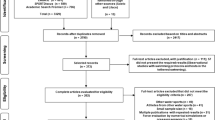Abstract
In order to optimize the swimming athletes’ turning technology and improve the athlete’s swimming performance, this paper analyzes the data collected with the help of computer technology, aiming to make coaches better guide the athletes to master essentials of turning technique. Based on the existing research results, this paper summarizes the kinematic parameters of the research object, and conducts reliability analysis of the kinematic parameters. Then with the time of turning 15 m as the core of the kinematic parameters, this paper explores the influence of kinematic parameters, such as the distance from the pool wall before turning, speed before and after turning and rollover time in the swimming process on the time of turning 15 m, and then sums up the key influencing factors of turning technique. Lastly, according to the related kinematic parameters, it puts forward some suggestions on the optimization of the swimming turning technique.





Similar content being viewed by others
References
Veiga, S., Roig, A.: Effect of the starting and turning performances on the subsequent swimming parameters of elite swimmers. Sports Biomech. 16(1), 34 (2017)
Wolfrum, M., Rüst, C.A., Rosemann, T., et al.: Changes in breaststroke swimming performances in national and international athletes competing between 1994 and 2011—a comparison with freestyle swimming performances. BMC Sports Sci. Med. Rehabil. 6(1), 18 (2014)
Skucas, K., Pokvytyte, V.: Combined strength exercises on dry land and in the water to improve swimming parameters of athletes with paraplegia. J. Sports Med. Phys. Fitness 58(3), 197–203 (2018)
Maree, L., van der Horst, G.: Quantification and identification of sperm subpopulations using computer-aided sperm analysis and species-specific cut-off values for swimming speed. Biotech. Histochem. 88(3–4), 181–193 (2013)
Liang, C., Ma, Y., Gao, C., et al.: Two-dimensional strain echocardiography technology for evaluation of myocardial strain in swimming athletes after high-intensity exercise. Echocardiography 34(2), 169–175 (2017)
Calfee, R.D., Puglis, H.J., Little, E.E., Brumbaugh, W.G., Mebane, C.A.: Quantifying fish swimming behavior in response to acute exposure of aqueous copper using computer assisted video and digital image analysis. J. Vis. Exp. (2016). https://doi.org/10.3791/53477
Pack, S., Kelly, S., Arvinen-Barrow, M.: “I think I became a swimmer rather than just someone with a disability swimming up and down:” paralympic athletes perceptions of self and identity development. Disabil. Rehabil. 39(20), 2063–2070 (2017)
Iglesias, X., Rodríguez-Zamora, L., Barrero, A., Torres, L., Chaverri, D., Rodríguez, F.A.: Monitoring internal load parameters during competitive synchronized swimming duet routines in elite athletes. Paper presented at the 18th Annual Congress of European College of Sport Science (2013)
Tinto, A., Campanella, M., Fasano, M.: Core strengthening and synchronized swimming: TRX® suspension training in young female athletes. J. Sports Med. Phys. Fitness 57(6), 744–751 (2017)
Bianco, G., Botte, V., Dubroca, L., et al.: Unexpected regularity in swimming behavior of clausocalanusfurcatus revealed by a telecentric 3D computer vision system. PLoS ONE 8(6), e67640 (2013)
Wolfrum, M., Rüst, C.A., Rosemann, T., et al.: The effect of course length on individual medley swimming performance in national and international athletes. J. Hum. Kinet. 42(1), 187–200 (2014)
Morais, J.E., Garrido, N.D., Marques, M.C., et al.: The influence of anthropometric, kinematic and energetic variables and gender on swimming performance in youth athletes. J. Hum. Kinet. 39(1), 203–211 (2013)
Figueiredo, P., Machado, L., Vilasboas, J.P., et al.: Reconstruction error of calibration volume’s coordinates for 3D swimming kinematics. J. Hum. Kinet 29, 35 (2011)
D’Ercole, S., Tieri, M., Martinelli, D., et al.: The effect of swimming on oral health status: competitive versus non-competitive athletes. J. Appl. Oral Sci. 24(2), 107–113 (2016)
Veiga, S., Mallo, J., Navandar, A., et al.: Effects of different swimming race constraints on turning movements. Hum. Mov. Sci. 36(6), 217–226 (2014)
Author information
Authors and Affiliations
Corresponding author
Rights and permissions
About this article
Cite this article
Bo, W. Data analysis of the turning technique process of swimming athletes assisted by computer technology. Cluster Comput 22 (Suppl 2), 3707–3714 (2019). https://doi.org/10.1007/s10586-018-2221-0
Received:
Revised:
Accepted:
Published:
Issue Date:
DOI: https://doi.org/10.1007/s10586-018-2221-0




